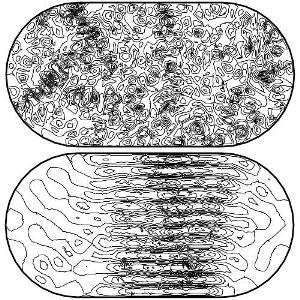May 21 2018
Scientists from Harvard and MIT have been recently successful in trapping an overwhelming 53 atoms. They were also able to individually control their quantum state, achieving something known as a quantum simulator.
 In quantum system, a probability map replaces the ball, but chaos and memory of classical trajectories also exist. (Image credit: IST Austria/Maksym Serbyn)
In quantum system, a probability map replaces the ball, but chaos and memory of classical trajectories also exist. (Image credit: IST Austria/Maksym Serbyn)
The experiments of the researchers in this system were presented at a conference in Trieste in July 2017 and demonstrate entirely unanticipated periodic oscillations in the dynamics of the interacting atoms. At present, an international research team, including Alexios Michailidis and Maksym Serbyn from the Institute of Science and Technology Austria (IST Austria) and also researchers from the University of Leeds and the University of Geneva, has resolved the mystery behind these erstwhile unaccountable oscillations. The theoretical interpretation put forward by the researchers presents a concept of a “quantum many-body scar” that transforms our knowledge of the dynamics that could occur in many-body quantum systems.
Consider the case of a ball that bounces around in an oval stadium. It bounces around chaotically, forward and backward through the available space. Since its motion is random, it will eventually travel to every place in the stadium. However, in between all the chaos, there could be a possibility for order: in the event that the ball hits the wall at a unique spot and at the “correct” angle of incidence, it might get into in a periodic orbit, traveling to the same places in the stadium again and again and not traveling to other places. A periodic orbit such as this is highly unstable since even the slightest of perturbations will deflect the ball off its track and back into chaotic travel around the stadium.
The same concept can be applied to quantum systems, but for the fact that in the place of a ball bouncing around is a wave, and instead of a trajectory, there is a probability function. Classical periodic orbits have the ability to make a quantum wave to be concentrated in its vicinity, resulting in a “scar”-like feature in a probability that would be uniform otherwise. These imprints of classical orbits on the probability function have been termed “quantum scars.” However, the phenomenon was only anticipated to occur with a single quantum particle, because there is a drastic increase in the complexity of the system with every additional particle, rendering periodic orbits highly improbable.
Generally people assumed that it was impossible for many-body systems to have quantum scars, and when people first saw the oscillations they could not explain it. By extending the concept of scars to quantum many-body systems, we were able to explain why these oscillations are there.
Maksym Serbyn, Co-Author & Professor at IST Austria
In this study, which was reported in the Nature Physics journal, the scientists have explained the experimental observation of the occurrence of quantum many-body scars. They have also determined that the coherent oscillation of atoms between the ground and excited states is the many-particle unstable periodic orbit responsible for the scar behavior. Instinctively, the quantum many-body scar might be visualized as a portion of the configuration space that is “shielded” from the chaos to some degree, thereby resulting in a considerably slower relaxation. Put differently, more time is needed for the system to return to chaos, that is, the equilibrium state.
“We still don’t know how common quantum many-body scars are, but we have found one example, and this is a paradigm shift,” stated Serbyn. However, there is much more to be discovered. “We don’t yet understand all the properties of many-body quantum scars, but we have successfully explained the data. We hope that a better understanding of quantum scars will provide a way of protecting quantum systems from relaxation.”